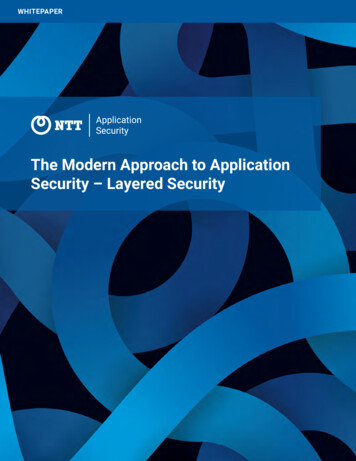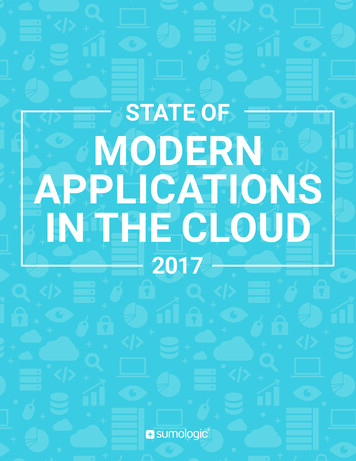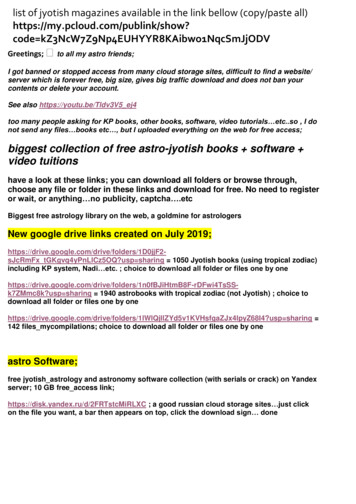
Transcription
WHITEPAPERThe Modern Approach to ApplicationSecurity – Layered Security
A LAYERED APPROACH TO APPLICATION SECURITY WHITE PAPERThe past three years brought forth a tremendous transformation in how we live and work. While the digital age hasseen technological advancements in almost every area of business, the COVID-19 pandemic introduced a seismiceconomic shift. In response, organizations acted quickly to migrate almost every aspect of their business online,accelerating an almost complete digital transformation, seemingly overnight. Fundamental to this shift has been theadoption of critical technologies, namely web applications. Organizations that were able to innovate and invest inapplications saw a competitive advantage as they adapted to the “new norm.”While business leaders heralded their successes inmaintaining workforce productivity, operational agilityand business profitability, they came face-to-face withthe realities of organized cybercrime.Organized Crime Represents 80% of Breaches0%20%40%60%80%100%40%60%80%100%Organized CrimeAlmost immediately, these threat actors beganattacking the very applications fueling those successes.Capitalizing on the global crisis and expanded attacksurfaces, threat actors worked tirelessly to attackapplication vulnerabilities and evade traditional securitymeasures.Now that the pandemic has started to release its gripand organizations begin to adopt hybrid work models,one thing has remained top of mind for businessleaders: getting proactive about their applicationsecurity strategy, and the risk to their business by notdoing so.OtherUnaffiliatedSystem adminEnd-userState-affiliated0%20%Source: 2021 Verizon DBIRCurrent State of AppSecIn the post pandemic economy, organizations need to accelerate their application security to the speed of modernsoftware development. Unfortunately, this “need for speed” requirement can often lead to vulnerabilities gettingreleased. Once these vulnerabilities can be identified once in production, so begins the process by which developersmust stop working on new projects to fix the vulnerabilities in live applications. Referred to as “context switching”,this constant shift between projects impacts productivity by slowing workflows, reducing efficiency and canultimately hinder overall system performance.While there is an increased focus on enabling security earlier in development, organizations continue to facecollaborative struggles between SecOps and DevOps teams and the functional roadblocks that result from eachgroup operating within their respective processes, tools and KPIs. With each team owning a stage of softwaredevelopment, identifying and remediating security vulnerabilities can become obstacles to productivity andinnovation.2
A LAYERED APPROACH TO APPLICATION SECURITY WHITE itorProductionIn this traditional model, security is designated to a specific, isolated team in the final stages of development. Andwhile this worked when development cycles operated under a monolithic application architecture, it is no longerviable following the wider adoption of Agile methodologies and development cycles. Now, teams can deliversoftware updates more often and in much shorter timeframes — sometimes multiple times per day.Enter DevSecOpsIn order to solve the aforementioned challenges to business operations and efficiency, organizations are increasinglyadopting a DevSecOps model to address security earlier in the SDLC. . This approach creates a bridge betweenDevOps and SecOps by expanding collaboration between the two teams to effectively deliver more secureapplications, all without affecting the speed and agility of development. Often referred to as “shifting left,” thisapproach moves security testing to software developers and enables them to fix vulnerable code in near real-time,rather than “bolting security” on at the end of the SDLC. DevSecOps offers a holistic approach to security throughoutthe SDLC — from planning and design to coding, building, testing and release — with continuous, real-time feedbackloops and insights.While the DevSecOps approach is a valiant effort centered around the idea that security is “everyone’s job”, itis not without obstacles. The implementation of DevSecOps can bring about a variety of challenges across anorganization: operationalizing a cultural shift, the realization of sub-par security knowledge and expertise and new,complex tool integrations to name a few.To aid in the implementation of a successful program, application security vendors have offered various solutionsthat enable DevSecOps throughout the stages of organizations’ CI/CD process. These solutions include StaticAnalysis Security Testing (SAST) and Software Composition Analysis (SCA) early in the development cycle, DynamicApplication Security Testing (DAST) for pre-production and production stage applications and Interactive ApplicationSecurity Testing (IAST) for functional testing.In “Collapsing Paradigms: Building AST from the Ground Up,” we highlighted the challenges to modern applicationsecurity that each of these traditional testing solutions pose, and elaborated on how the traditional approachof relying on a single point-product solution no longer meets the needs driven by agile development and rapidsecurity fixes. Now, even if developers deliver secure code that is tested and validated by DevOps, vulnerabilitiescan still leave an application exposed after connecting to other third-party applications and APIs after going live inproduction.While there are clear, definite challenges to these application security testing methodologies, there is anotherapproach available — one that’s already proven to be widely adopted and successful within network security teams.3
A LAYERED APPROACH TO APPLICATION SECURITY WHITE PAPERA “Tried and True” ApproachIn network security, the “layered approach” concept has become a widely accepted and successful strategy forreducing the risk of compromise. In the IT context of perimeter security, layered security is defined by deployingseveral independent layers of security solutions so that it is much harder for a threat actor to penetrate the network.If an attacker breaches one layer of security, there is another layer safeguarding the network and its resources. If thislayer is breached, there is yet another that can prevent compromise. Also known as a “defense-in-depth” strategy, alayered approach is also centered around the simple premise that multiple layers of security provides multiple layersof protection.While there are pros and cons to a layered security strategy on the perimeter, the benefits become clear whenapplied to application security.Applying the Defense in Depth approach to AppSecR E L E AS EDEVOPSBUILDTESTP L ANDEPLOYAs Figure 1 shows, the software developmentlifecycle model is continuous and is representedas an infinite loop. However, when applyingapplication security testing to the model,gaps begin to appear when developers switchcontext from writing new code to fixing existingcode. By implementing DevSecOps andleveraging purpose-built application securitytesting solutions designed specifically for eachfunctional group, the SDLC is empowered by aninfinite loop of security.COD EIn applying the concept of a layered perimeter security strategy to application security, the debate over whichapplication security testing method (i.e., SAST vs. DAST) becomes irrelevant. Rather than arguing the merits ofone testing method over another, the layered approach stresses that organizations should adopt all methods. Byadopting a layered security strategy and applying it to the SDLC, organizations can help improve efficiencies withinthe CI/CD pipeline, operationally test code where it is being developed and ensure its production applications aresecure.O P E R AT EFigure 1: Software Development LifecycleWhen each functional group within the SDLC has the ability to test within their native environments, securityvulnerabilities are identified earlier and more efficiently. Additionally, by applying purpose-built testing at the mostcritical inflection points of the SDLC, developers, DevOps and security teams become empowered with accurate andcontextual security insights as they build, run and deploy web applications and APIs.Whether through a managed security service provider or a self-service SaaS platform, organizations that adopt bothDevSecOps and a layered approach to application security can fully realize the power that applications can bring totheir business’ productivity and bottom line.4
A LAYERED APPROACH TO APPLICATION SECURITY WHITE PAPERSELF GEDAttack Surface DiscoveryProfessional Services Security Program Management Professional Services EngineeringNTT APPLICATION SECURITY 1741 Technology Dr. #300, San Jose, CA 95110 1.408.343.8300 www.whitehatsec.com 2022 NTT Application Security. All rights reserved. Premium Support OnboardingRunMonitorProduction
In applying the concept of a layered perimeter security strategy to application security, the debate over which application security testing method (i.e., SAST vs. DAST) becomes irrelevant. Rather than arguing the merits of one testing method over another, the layered approach stresses that organizations should adopt all methods. By











